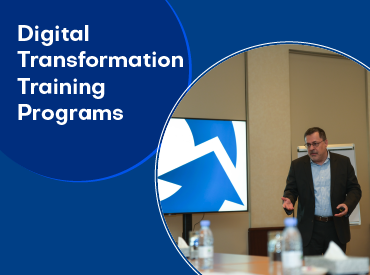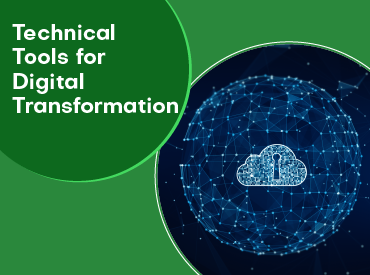Digital transformation is one of the most important topics in our time, the world today is going digital, and any organization wants to remain within the competition in the market; It must embark on digital transformation because of its many benefits and positives. Digital transformation represents a radical rethinking of how the organization uses technology, people, and processes to radically change business performance.
Digital transformation, led by the CEO in partnership with CEOs, HR managers, and others, requires prudent digital leadership and interdepartmental collaboration in pairing business-focused philosophies with rapid application development models.
Digital leadership concept
Digital leadership can be defined as the leader’s contribution to the transformation towards a knowledge society, and the extent of his knowledge in the field of technology, which is the strategic use of the company’s digital assets to solve business problems and meet its needs, and this can be dealt with at the organizational and individual levels, and when viewed from the individual level often This is performed by those responsible for supervising digital assets.
Successful strategies for achieving digital leadership
The strategies for successfully achieving digital leadership are summarized in four basic principles that you can follow, as follows:
First: Work on formulating a sophisticated digital strategy based on introducing the organization and the nature of its work, especially if its success in the set goals depends – directly or indirectly – on creating a digital entity (or entities) for it, translated into a clear and detailed plan for the digital content that will be on the channel Connecting the voice, goals, services, and products of this organization to its digital audience.
Second: Tactics and mechanisms must be put in place for the optimal use of social media that meet the organization’s needs in reaching its digital audience, continuous communication with it and its development, to avoid errors that may sometimes be harmful to the organization’s reputation and the integrity of its brand or marketing, as not all social media is suitable for all institutions or organizations, There are no written rules that compel organizations to create a digital presence in all of these media.
Third: Should start to formulate the strategies and mechanisms referred to in the above from an in-depth understanding of how to manage brands or marketing and develop their market value, and to seek the help of experts in developing visual aids, including pictures, drawings, and videos. Because of its significant impact on the enrichment of trademarks and the enhancement of the public’s attachment to these marks and their perception of them.
Fourth: Managing websites and updating their content and regularity of the content published on all social media and vice versa, to ensure integration between all of these means, whether informative or advertising content, and work regularly to analyze user and visitor statistics and interact with these means and the content posted on them And using these statistics in developing the set plan and modifying it to ensure the achievement of the organization’s goals, the most important of which is attracting new customers who benefit from the services and products of the organization, or who support the goals or issues it represents, or who contribute to what it promotes – whatever that is.

Digital leader’s patterns:
According to the authors of (The New Leadership Playbook for the Digital Age) book, we can categorize entrepreneurs, or rather leaders in the era of digital transformation in which we are currently living, into four basic types as follows:
The producer leader: Typically, a producer leader focuses on generating results through digital expertise, analytics, innovation, rapidly, and customer focus. In other words, this mindset of leadership leverages all modern digital technologies to find concrete and tangible results.
The investor leader: This is a unique mentality of leaders as well; As this type of leader does not focus on achieving short-term objectives, but rather serves a purpose greater than growth and shareholder returns; Its focus towards achieving sustainability, bringing benefits to society, and providing long-term benefits.
Conducting Leader: This leader plays to the rhythm of a distant melody, as his focus is on building effective relationships, communication, and cooperation; To create real value, relationships are an important social capital, and those in leadership in the era of digital transformation are well aware of this.
The explorer leader: This leader fantasy to open new horizons and reach methods, practices, and opportunities that no one has found before, and he is driven – during all of this – by curiosity, the desire to experiment, and the feeling of the ability to do the impossible.
The most prominent skills of digital transformation leaders
Deloitte reports that 42% of larger companies now believe it is very important to develop leaders, and that success in this digital age depends heavily on it. Below we will list the most important skills required for digital leaders:
- Communications: Using technology, digital leaders can build a robust top-down business communications network. But to do so, digital leaders need to have a strategy in place and understand who they’re dealing with.
- Vision – You must have a clear and strong vision; it is easy to involve the workforce with you when they believe what you believe in. We can say that this is one of the traits that make digital leaders stand out from the rest.
- Digital Literacy: HBR the research results which it conducted with 1,000 CEOs show that 90% of them believe their businesses are being disrupted or reinvented by digital business models. And When they asked about their capabilities, 70% of them believe they do not have the right skills, leader, or appropriate operational structure to adapt to the digital nature.
One of the problems facing industries is that the older generations, known as “digital immigrants”, are forced to learn new technologies. Digital leaders need to engage with technology and tools and bring the entire workforce with them.
- Strategy – Not only must digital leaders have a clear vision of the future, but they must also have a strategy in place that helps foster digital culture internally and is ready to embrace changes. For this to happen, it is important to have a coherent strategy that defines the digital agenda.
- Innovation: The digital landscape is constantly evolving in the digital age, and leadership must be willing to experiment with new technologies, and to do so it must be flexible and adaptable to the approach of those technologies in creating a digital workforce.
But there are often calculated risks involved in this step, such as: trying new systems and technologies for which you have little evidence or examples of success, but the rewards can be very beneficial. This brings us to the next point which is “risk”.
- Risk: Putting speed and innovation at the forefront of tried and tested technologies is something that organizations should be careful of. However, the risk is an essential part of digital leadership, and this has been endorsed by Mark Zuckerberg, CEO of Facebook, who stated That “the biggest risk is not taking risks.” In a world that is changing so rapidly, the only guaranteed strategy to fail is not to take risks.
- Adaptability: When changes occur in an industry or a business, the digital leader must remain adaptable and ready to make decisions that will have a major impact on the business, a leader who does not want change or is proactive will stop work. Forbes believes that adaptability is one of the key skills of a digital leader.
- Talent discovery: Digital leaders must be able to identify areas that need improvement within their business, and which may be likely to lack talent, as the human factor is just as important as technology.
The role of organization leaders in overcoming the challenges facing the digital transformation journey
Digital transformation has already afflicted every industry, and many companies are still hesitant to make the digital transformation decision due to the leadership’s insufficient sense of the need for change yet. Unfortunately, in most companies, the leadership prefers to react to threats rather than be proactive about the future! One of the reasons for this approach is that the leadership is unaware of future challenges, and does not know where the company stands today, where it should be, and how to start.
As a company leader, you must create the right sense of urgency and momentum around digital transformation and be able to overcome these challenges and manage them effectively. We can summarize the 6 most important challenges facing the digital transformation process and how to overcome these challenges:
Challenge one – Defining a clear vision: It is important to have strategic clarity to understand what drives the need for change in your business, and then be able to define a vision to address deficiencies.
You can overcome this challenge by following the following solutions:
- Clearly define the factors that drive you to change: Do not base your strategy around vague concepts such as competitive pressure or customer expectations. You must be able to take all of your drivers of change and plot concrete goals against them.
- Find out where you are and where you want to be: You must understand the maturity of your current digital capabilities and the capabilities you want in the future. Then plot the main events in the journey so you can see that you are making progress toward your goal.
- Creating a Shared Vision: Digital transformation requires an enormous amount of change management, which means making your vision clear to all stakeholders and trying to mobilize them around it. Describe the business needs to kick-start the digital transformation process, and help people understand how moving forward in their digital transformation journey will make a difference for themselves and the organization.
Challenge Two – Working Better Together: There has to be organizational alignment to enable proactive cooperation.
You can overcome this challenge by following the following keys:
- Enhance your digital leadership: You need a leader who can lead the change of the organization’s agenda and overcome any resistance to change.
- Engage your peers: Create an implementation team that brings together all the experts in business and technology, ensuring that everyone on the team is kept informed.
- Work on a common language to drive collaboration: Presenting updates visually, but not limited to, can help stakeholders – from various disciplines – understand what is going on, facilitate the matter in a simpler way, and facilitate communication and discussion about it.
Challenge Three – Enabling Business Agility: Organizational deprivation combined with digital transformation often stems from an inability to make change quickly.
You can overcome this challenge by following the following keys:
- Think big, start small, and fast: Your transformation initiative needs a bold and ambitious vision of course, but to create the momentum profile needed to achieve this, you must start with a small test case and then plan to scale it quickly.
- Plans to support change: Define your digital architecture and assets in a way that allows you to get the most out of what you already have, reuse assets whenever possible, avoiding fast and illegal things and methods that require extensive and long maintenance; Because that may harm your ability to innovate in the long run.
- Don’t expect perfection in the first place: Innovation will likely come from an iterative approach that supports prototyping and testing. Test ideas, run live prototypes and see how well they perform, so you can quickly make changes to the next iteration.
Challenge four – Insufficient time and money: Plans are changing, this is an irrefutable fact. Therefore, the processes that support the stages of digital transformation must be responsive.
You can overcome this challenge by following the following keys:
- Create a self-empowering team: Transformation is a never-ending process, so relying heavily on outside expertise to bring about change will be costly. Instead, find a way to create and maintain an in-house production team, but be aware of how much training investment this will require.
- Not all changes are equal: The cost of ownership and the cost of change must be major factors in the technology you use to support the business. Periodic changes or changes that are part of nature should be handled smoothly without much effort on your team.
- Create a culture of change that promotes measurable innovation: Experience can be fostered by putting success metrics and indicators in place. Providing visibility of results achieved in terms of the time and money invested will encourage a more innovative internal approach.
Challenge five – Finding Flexible Technology: To create resilience and respond to new opportunities in the future, companies need the appropriate platform for continuous digital change, which integrates with existing structures, and creates improvements without disrupting and delaying productivity.
You can overcome this challenge by following the following keys:
- Look for cover technologies for IT.
- Look for platforms that natively support integrations with your existing business systems.
- Ensure that any vendor you work with takes responsibility for quality assurance in the integration process.
- Cover technology sellers must be energetic, healthy, and innovative.
In conclusion, we conclude that the digital transformation process adds a new dimension to traditional business challenges. Therefore, organizations need to rethink their traditional origins through a digital lens and learn how they can create new possibilities in the new era.
Throughout the digital transformation journey, some assets will remain useful, others will not, and data and insights will be new sources of value in the digital world. If the functional approach sometimes works in traditional transformation, then digital transformation does not respect organizational boundaries, and you must have executives who are biased to the idea of digital transformation as a team and have the authority to lead the change.


















